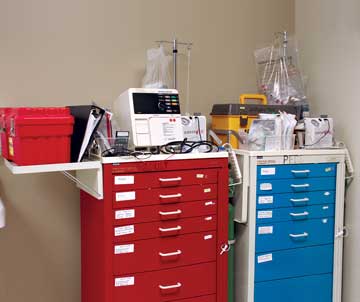1What’s your plan? Long before you have an emergency, you should craft an emergency plan and go over the essential roles.
All the members of the staff, from the assistants at the front desk to the clinicians in the OR, need to know their role. During an emergency, you should know who will meet the ambulance crews and who will do CPR. You need a point person to organize
the staff and to document medications and event times. Having defined roles decreases confusion in a crisis.
Emergency plans are not one-size-fits-all. A hospital outpatient surgery center adjacent to an ER will have a much different emergency plan than a freestanding ambulatory surgery center. If you perform pediatric cases, you’ll need to develop
specific guidelines to that patient population, as well.
2Code cart and supplies. How often are you taking inventory of your code cart? Every facility should have fully stocked crash carts with all of the drugs and equipment recommended by the American
Heart Association. You also should have a dedicated malignant hyperthermia plan.
Imagine reaching into your crash cart for the one drug you need to revive a patient and discovering it’s on back order. It’s an easy mistake to make, and it’s easily preventable. Do a monthly inventory check and make sure all
your drugs and supplies are available and up to date. That’s also true of your automated external defibrillator. Keep track of the pads and battery on your AED, and you’ll be ready for a patient who goes into sudden cardiac arrest.
3Practice makes perfect. It’s one thing to have policies. It’s another to be ready for an emergency. Mock drills help your staff understand the different roles they’ll need
to assume in a crisis.
Every few months or so, you should run through an emergency drill from beginning to end. Your patient has a severe allergic reaction. What do you do? Who’s managing the code cart? What drugs do you need, and when do you call 911? Everyone
should be flexible enough to step into a different role. Your staff should be trained and certified in basic and advanced levels of life support, so they’re ready at a moment’s notice.
4Discharge criteria. Treat ‘em and street ‘em? Don’t do it. You should never be in a rush to get patients home. Your providers need to follow your facility’s rules and
patients must meet discharge criteria before you discharge them. A hasty discharge can have fatal consequences. We’ve seen several cases where patients died on the car ride home. Don’t make the mistake and think a seemingly stable
patient is OK to send home if the patient hasn’t met all of your discharge criteria — stable mental state, can ambulate, pain is controlled, can tolerate food and drink, able to void, for example — and has a friend or family
member to drive her home.
5Learning experiences. Emergencies put your preparation and policies to the test. Debriefing after an emergency is always a good learning experience. Did you follow ACLS protocols? Did someone
record in your CPR code sheet who intubated the patient, and when the first medication and CPR began? Was someone available to give the appropriate medications?
.svg?sfvrsn=be606e78_3)

.svg?sfvrsn=56b2f850_5)